EGYPTIANS AND NUBIANS
The cultures of Egypt and Nubia are the ones most often claimed by Afrocentrists, usually Americans of West African descent. But the data from anthropology and genetics reveals the Caucasoid make-up of Egyptians, both ancient and modern, and places Nubia, which acquired a partly Negroid character, in the Afro-Asiatic cultural complex, separate from sub-Saharan and West African groups.
Anthropology
EGYPTIANS
"One such concentration of [Paleolithic] food-gatherers is seen in the Sebilian culture of Upper Egypt. The skeletal remains from this culture, which have not yet been published, are said to anticipate in physical type the predynastic, placing a fine Mediterranean type in pre-Neolithic times.
"The importance of these [early Neolithic] people is that they probably represent the prototype of the Neolithic agriculturalists who moved westward along the shore of North Africa to Morocco, and over into Spain, whence they spread the Neolithic economy, with emmer flax, and swine, to the Swiss lakes and to the Rhine. ... The skulls of these people, which consist mostly of females and infants, are all dolichocephalic and Mediterranean. There is no trace of negroid influence and the skulls are said to be larger than those of predynastic Egyptians....
"The [pre-Dynastic] Badarian type represents a small branch of the Mediterranean racial group. ... The Badarian skulls are more prognathous than those of their successors, and have higher nasal indices. ... In fact, while the prognathism and nose form would suggest a negroid tendency, this cannot be established, since the hair form is definitely not negroid. ... Morant shows that the Badarian cranial type is closely similar to that of some of the modern Christians of northern Ethiopia—who incidentally do not show negroid characteristics in the skull—and also to the crania of Dravidian-speaking peoples of southern India. ... On the basis of these racial comparisons, it seems reasonable to suggest that this Badarian physical type may have come from the south, near the headwaters of the Blue Nile. It may represent an early Hamitic racial strain, which persists despite some negroid admixture in Ethiopia and Somaliland to the present day.
"In Lower Egypt lived another group of Mediterranean predynastic people who differed from the Upper Egyptians in certain noticeable ways. The heads were broader, the cranial indices higher, reaching a mean of 75, whereas the Upper Egyptian mean is nearly 72. The vault height is less, the face is no broader, but somewhat longer, and the nasal index is lower.
"The two types from Upper and Lower Egypt represent the extremes of a purely native Egyptian population, but from the beginning of dynastic times, around 3000 B.C. until Ptolemaic times, the numerous series which give an excellent picture of the progress of racial continuity and change in Egypt show the interactions of these two types. The racial history of Egypt in the course of three thousand years was simply the gradual replacement of the Upper Egyptian type by that of Lower Egypt. ... Ancient Egypt must remain the most outstanding example yet known in the world of an important, naturally isolated region in which native racial types were permitted to develop their own way for several thousand years completely uninfluenced by foreign contacts.
"The wealth of contemporary illustrative material from Egyptian art sources may be divided into two classes, conventional representations and portraits. The former show a definite and well-recognized type; slender-bodied and wiry, with narrow hips and small hands and feet. The head and face are those of a smoothly contoured fine Mediterranean form.
"The pigmentation of the Egyptians was usually a brunet white; in the conventional figures the men are represented as red, the women often as lighter, and even white. ... the hair is almost inevitably black or dark brown, and the eyes brown.... The Egyptian representation of foreigners is quite accurate; besides the Libyans, who have Nordic features as well as coloring, Asiatics, with prominent noses and curly hair, sea peoples from the Mediterranean, with lighter skins and a more pronounced facial relief than the Egyptians, are also shown, as well as negroes. ... The Mediterranean pigmentation of the Egyptians has probably not greatly changed during the last five thousand years."
* * *
NUBIANS
"Starting from the Late Neolithic...similarities between the Nubians and the populations of Northeast Africa...and Asia...became even more distinct, which may prove the existence of strong ties derived probably from influx of the Caucasoids from the regions of Levant, Mesopotamia, and India. They were coming to Nubia through the Sinai Peninsula, but probably also through the south Saudi Arabia. The Kerma series from Upper Nubia shows particular similarities to the present-day Indian series."From the Neolithic on, or possibly even earlier, the strategic location of Nubia, promoting contacts between various populations, started to bring about effects in the form of the civilizational development of this region. Finally, these two factors led to the Hamitisation process, whereby superimposition of the Caucasoids on the Negroids took place."
Genetics
"To assess the extent to which the Nile River Valley has been a corridor for human migrations between Egypt and sub-Saharan Africa, we analyzed mtDNA variation in 224 individuals from various locations along the river. Sequences of the first hypervariable segment (HV1) of the mtDNA control region and a polymorphic HpaI site at position 3592 allowed us to designate each mtDNA as being of 'northern' or 'southern' affiliation. Proportions of northern and southern mtDNA differed significantly between Egypt, Nubia, and the southern Sudan.
"...we can infer that the migration of northern mtDNA types to the south is older than the migration of southern mtDNA types to the north (or that there has been less gene flow from north to south than from south to north along the Nile River Valley) and that Egypt and Nubia have had more genetic contact than either has had with the southern Sudan. Moreover, we can tentatively infer that these migrations occurred recently enough to fall within the period of the documented historical record of human populations in the Nile River Valley."
(Krings et al. 1999)
* * *
"...the present study on the Y-chromosome haplotype shows that there are northern and southern Y-haplotypes in Egypt. The main Y-haplotype V is a northern haplotype, with a significantly different frequency in the north compared to the south of the country: frequencies of haplotype V are 51.9% in the Delta (location A), 24.2% in Upper Egypt (location B), and 17.4% in Lower Nubia (location C). On the other hand, haplotype IV is a typical southern haplotype, being almost absent in A (1.2%), and preponderant in B (27.3%) and C (39.1%). Haplotype XI also shows a preponderance in the south (in C, 30.4%; B, 28.8%) compared to the north (11.7% in A) of the country.
"It is interesting to relate this peculiar north/south differentiation, a pattern of genetic variation deriving from the two uniparentally inherited genetic systems (mtDNA and Y chromosome), to specific historic events. Since the beginning of Egyptian history (3200-3100 B.C.), the legendary king Menes united Upper and Lower Egypt. Migration from north to south may coincide with the Pharaonic colonization of Nubia, which occurred initially during the Middle Kingdom (12th Dynasty, 1991-1785 B.C.), and more permanently during the New Kingdom, from the reign of Thotmosis III (1490-1437 B.C.). The main migration from south to north may coincide with the 25th Dynasty (730-655 B.C.), when kings from Napata (in Nubia) conquered Egypt."
* * *
"The Hpal (np3,592) mitochondrial DNA marker is a selectively neutral mutation that is very common in sub-Saharan Africa.... From 29 [Merotic Nubian] individuals analysed, only 15 yield positive amplifications, four of them (26.7%) displaying the sub-Saharan African marker. Hpa 1 (np3,592) marker is present in the sub-Saharan populations at a frequency of 68.7 on average. Thus, the frequency of genes from this area in the Merotic Nubian population can be estimated at around 39% (with a confidence interval from 22% to 55%). The frequency obtained fits in a south-north decreasing gradient of Hpa I (np3,592) along the African continent. Results suggest that morphological changes observed historically in the Nubian populations are more likely to be due to the existence of south-north gene flow through the Nile Valley than to in-situ evolution."
Racial Types
Some typical Egyptians, representing the phenotypes described by Coon:
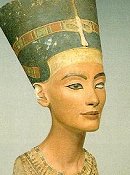
Nefertiti |
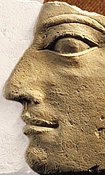
Hemiunu |
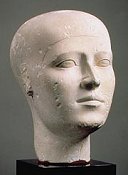
Limestone Head |
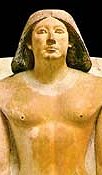
Ranofer |

Nefertem |
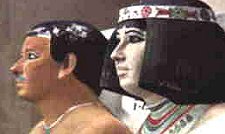
Rahotep and Nofret |
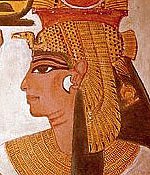
Nefertari |
Related Topics
The Ancient Egypt Race Issue: Comprehensive refutation of Afrocentrist claims to Egyptian civilization.
King Tut Reconstruction: Forensic evidence showing that King Tutankhamun was Caucasoid.
North Africans: Genetic data showing the peoples of North Africa to be predominantly Caucasoid.
